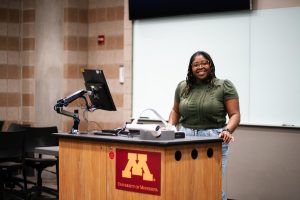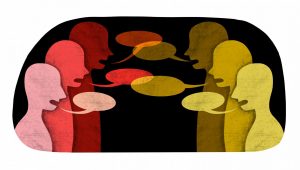AEditor’s note: This article is the last in a four-part series that features prominent black figures at the University in honor of Black History Month.
 lthough the University is home to more than 1,700 black students, it wasn’t always this way.
lthough the University is home to more than 1,700 black students, it wasn’t always this way.
Between the two world wars, the University was a place where black students came, but weren’t always welcome.
Today’s profiles feature two alumni who attended the University during that period and fought through discrimination and adversity to obtain their education.
Donald “Bill” McMoore
The University’s athletics department might have been considered radical for accepting black athletes during the late 1940s, but Donald “Bill” McMoore at times found the department less than welcoming.
McMoore was born and raised in south Minneapolis, graduated from South Minneapolis High School and came to the University in 1947.
“He was one of the premier athletes in the Minneapolis public schools,” Daryl McMoore, Bill’s son, said of his father.
“I always wanted to go to the University,” Bill McMoore said, and following a stint in the U.S. Navy, he was able to do so with the tuition aid the GI Bill awarded him.
Once at the University, Bill McMoore studied health and physical education. He was also a boxer and a member of the football team.
Joseph Mackey was one of Bill McMoore’s boxing teammates and drove him to school every day.
“I was his roommate on road trips,” Mackey said.
Mackey said he remembered a train trip to Spokane, Wash., when the team was allowed to exercise and train in the luggage car.
“I couldn’t find a better guy,” Mackey said, “He’s just a stand-out person. He was a pillar of the University.”
Bill McMoore said his teammates accepted him, but when it came time for the boxing team to travel to Miami for a match, he was forced to stay home.
“The coach informed me the day before the match that I couldn’t go,” he said, “because they didn’t allow mixed matches in the South.”
University President James Morrill later offered him a public apology in the newspaper, as Morrill was not involved in the decision, Bill McMoore said.
Morrill also stated that the University no longer would participate in contests in which black students were barred from competition, he said.
Despite Morrill’s decision, Bill McMoore said, “There wasn’t much effort put forth to change things (on campus). That’s the way things had always been.”
Bill McMoore said that although he had grown up in Minneapolis and always had wanted to attend the University, having had the experience, he wishes he would have attended one of the historically black universities or colleges of the South.
“I think the experience one gets (at an all-black college), being part of the whole program, would be very important to me now, as an adult,” he said.
After his University days, Bill McMoore said he had difficulty getting a job in Minneapolis, so he took a job in Missouri for three years, then attended graduate school in St. Cloud, which was “terrible; a very, very racist community.”
Bill McMoore, after various teaching jobs, eventually became the director of physical education for the Minneapolis public school district.
“It shows that perseverance pays off,” Daryl McMoore said. “He never gave in. He didn’t let obvious setbacks and obvious discrimination and obvious racism deter him from what he wanted to do.”
When Daryl McMoore entered the University in 1984, it was a much different school from the one his father attended, he said.
“That infrastructure was there,” he said of the black student union and other multicultural centers. “They had programs in place that provided an outlet for black students.”
Charles Self, former assistant Facilities Management director, said he met Bill McMoore through mutual friends in the late 1950s. When they see each other nowadays, Bill McMoore reminisces about his former students.
“He tells me about some of the kids that he had, what they have done, and how he runs into some of them,” he said. “He’s very proud of the kids that he has come in contact with and taught.”
The University has changed and grown since the time when Bill McMoore attended.
There are black faculty members and there are institutions put in place to help black students.
And although the University has come a long way, “there’s always room for more progress,” Bill McMoore said.
Barbara Cyrus
After more than 60 years, Barbara Cyrus, a 1938 Minneapolis Central High School graduate, is able to speak pleasantly about the discrimination she faced while attending the University.
At that time, being a black student on campus was rare, but being a black woman on campus was even rarer.
Growing up in south Minneapolis, Cyrus said, she was “never self-conscious about being black” even though hers was the first black family in the neighborhood.
She said that even as a 7-year-old, she found the people there who were upset about their integration of the neighborhood “unstable.”
The summer before she entered the University, Cyrus stayed with a University student who helped prepare her for entrance exams.
“We didn’t have counselors then, in high school,” she said, “And if so, they didn’t pay any attention to you. The only reason I knew what you needed to get in to the University is because I sent away for a book, so I knew which classes to take.”
And so, Cyrus entered the University and attended class with some of her white peers from grade school and high school.
“I was kind of surprised,” she said of her former peers. “When I saw them at the University, all of a sudden, we didn’t speak any longer.”
The other people in Cyrus’ classes were not friendly toward her either.
One person reached out to Cyrus, she said: a student from New York named Loren Brink.
“He was the only person I remembered through all these years,” Cyrus said. “We had the same three classes, and he walked with me (to them).”
Because Brink reached out to Cyrus and befriended her, it caused some students around them to do the same, she said.
One of her earliest University memories was a time when prominent black singer Marian Anderson came to campus.
Anderson was not allowed to stay in the Minneapolis hotels unless she used a back elevator, Cyrus said, so Anderson stayed with an instructor at the music school.
As a member of the sorority Alpha Kappa Alpha, Cyrus was invited to have tea with Anderson.
“We sat around the floor at her feet,” she said, “and talked to her, asked her questions about her life. I don’t know if today people would be so very, very kind.”
Cyrus said she still remembers the saddle shoes and plaid knee socks she and the other girls wore and the antique furniture in the building.
“It was really just a beautiful afternoon to spend with someone like her,” she said. “I encountered her later on in life, but that was the first time and probably the nicest one.”
The pleasant experiences at the University were contrasted sharply by more controversial events, such as the planned production of George Gershwin’s musical “Porgy and Bess.”
Rose Oyamot, a library aide at the Hosmer Community Library where Cyrus recently volunteered for a year, said Cyrus told her about the scandal during one of their interviews.
Cyrus had been cast in a role, Oyamot said, and also was helping to produce the play.
Members of the community found the play to portray blacks in a discriminatory light and protested the production, she said.
In the end, the play was banned from production at the University, Oyamot said.
“I had really hoped to be in theater,” Cyrus said of her missed opportunity, “but it was not time for African women yet.”
Aside from a few opportunities for chorus line roles given to light-skinned blacks, there were always “ubiquitous maid roles,” she said, and she took one such role in high school.
After leaving the University, Cyrus was a newspaper reporter and active member of the civil rights movement.
Her column, “Et Cetera,” was featured in the St. Paul Sun and the Twin Cities Observer, Oyamot said, and discussed topics untouched by the major daily newspapers, mostly concerning the black community.
“She was outspoken and infamous,” Oyamot said. “I find her very inspiring.”
Cyrus said that during the 1960s when the Morrill Hall takeover took place on campus, she was very concerned.
“It was really very, very sad,” she said of the students’ trials, which she left work to attend. “(The takeover) was never as dangerous as the newspapers said.”
People’s attitudes around the Twin Cities were such that they “thought nothing unpleasant could happen to people at the University,” she said. And if bad things did happen, the victim often was blamed.
Hosmer librarian Roy Woodstrom said Cyrus has been able to take the experiences from her life and offer today’s community many opportunities.
Cyrus faced mistreatment, Woodstrom said, for being black and going to school, but she persevered and got through.
During her year at Hosmer, Cyrus focused on bringing speakers and musicians to let “people see the richness and the diversity that we have in this neighborhood,” he said.
As an octogenarian, Cyrus has not let age stop her, Woodstrom said.
“She hasn’t stopped being an influence, hasn’t stopped being a mentor and hasn’t stopped brining an impact (to her community),” Woodstrom said.







